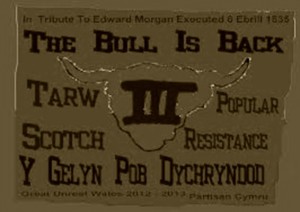The ‘Scotch Cattle’ movement first appeared in the early 1820’s.The movement was formed by disgruntled workers mainly from the coal mines of the Monmouthshire valleys.
One of the main objects of the organisation was to prevent strangers being taught the art of mining, thereby restricting the output and minerals. No miner was allowed to take a stranger underground without first consulting the organisation. If this rule was violated the offender was warned that violence will be the punishment. Destruction of furniture, bodily violence and sometimes murder would follow. In February 1822 Russell and Brown owners of the Blaina works proposed to lower the wages 5 to 6 per cent and also to lower the prices of provisions in the Company Shop by 10 to 15 per cent. The workers refused to accept the proposal and struck work.
After the strike continued for two weeks the workers became desperate. Black legs were introduced and this irritated the miners more than ever. The works manager’s house was stoned and a Bull’s head painted in red on the doors of the black legs houses.
The Bull’s head was a warning sign that the ” Scotch Cattle ” would strike. The black legs that were brave enough continued working and the night following the warning the ” Scotch Cattle ” struck. On the night of February 17th between 150 and 200 men met near a Cornish pit.
The men were commanded by their leaders to turn their coats and blacken their faces, and order which was promptly obeyed by the mob. Then the procession headed by the leader blowing a horn descended on the cottages of two of the marked men. Windows was smashed, the door forced open, all the furniture would be destroyed and the occupants beaten in a most brutal manner. This included women and children.
The “Scotch Cattle” existed as a secret society with its members sworn to allegiance under sufferance of death. Each valley town and village had its own cell (a pattern still adopted by current terrorist organisations) and a leader was elected, usually a person respected and feared for his aggressiveness and physical strength, known as the ‘Bull’ or in Welsh ‘Tarw’. Their meetings were always held in complete secrecy, normally in dark secluded locations. Normally, this thuggery would be undertaken by a herd from another area to avoid recognition by local residents.
Their meetings were always held in complete secrecy, normally in dark secluded locations.
Normally, this thuggery would be undertaken by a herd from another area to avoid recognition by local residents. The Cattle’s code, however, dictated that any foodstuffs found in the household would always be left intact. Company property was also targeted, with buildings ransacked and burned down.
Despite attempts by the authorities to infiltrate the movement and bring the ring leaders to justice, their activities continued for many years mainly due to the extreme secrecy of their organisation and the reluctance of the general population to speak against their actions, doing so would lead to a visit from the “Cattle”.
Eventually the military were called in, but they were unable to prevent the ” Cattle ” from continuing their violent tactics. On Sunday April 22nd they went over the mountain in the dark to Abersychan and destroyed the house of a blackleg who worked in Nantyglo. A reward of £15 (a very large reward for those days) failed to gain any information.
Such was the fear of revenge and the solidarity of the workers. Lord Melbourne the then Home Secretary was obliged to visit Abergavenny to discuss the matter with the local magistrates. One notice written in red ink (symbolising the blood of workers) and in the Welsh language was as follows: ” To all colliers, traitors, turncoats and others. We hereby warn you for the second and last time. We are determined to draw out the hearts of all the men above named, and fix two hearts upon the horns of the bull, So that everyone may see what is the fate of every traitor and we know them all ”.
As time passed, however, the original aim of the movement became forgotten and now innocent people were being attacked, robbed and even killed.
On 28th October 1834 two scotchings were carried out in Argoed. In the course of the operation a gun was fired, the discharge wounded Joan Thomas the wife of a blackleg and Edward Morgan, a member of the herd. Joan Thomas died two days later from her wounds, her husband being too scared to seek medical attention. Edward Morgan returned home severely wounded and was arrested not long after this incident. The killer of Joan Thomas is alleged to have escaped to America, Edward Morgan was not so lucky. He was just 32 when the courts in Monmouthshire found him guilty of murder. He faced the executioner outside the Monmouth Gaol on 6th April 1835.He died expressing the wish that “content” would be restored to the working classes. The Bull that night was named as Ned Lolly, a man with Staffordshire origins, but this information came out much later, in fact too late to save Edward Morgan.
The Scotch Cattle were nearing its end, the execution of Morgan and later the revealing of the names of other Cattle members brought an end to violence and destruction caused by this movement. Some believe that the Cattle were the very beginnings of Trade Unions.
